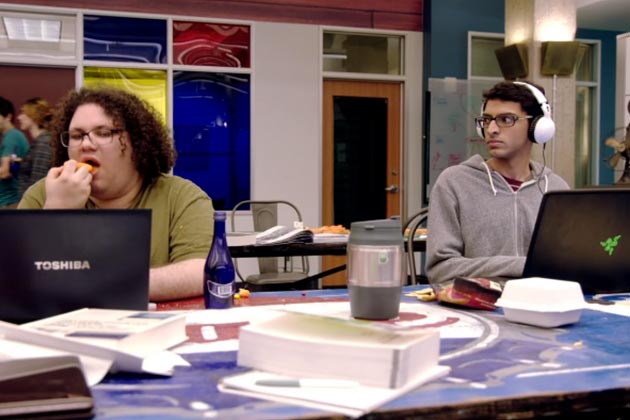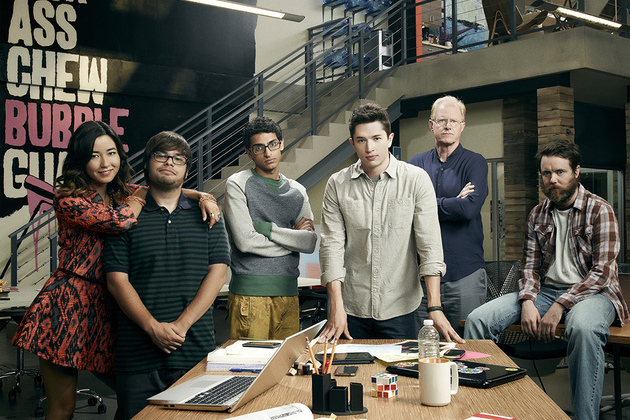Amazon’s Betas: From the Valley to the City
 Amazon’s new series, Betas, opens with a google maps-like zoom from the earth to the suburbs of Silicon Valley, somewhere between Palo Alto and Mountain View, finally stopping at the Mind Hub Communal Workspace. Inside, Nash (Karan Soni), a sometimes painfully stereotyped Indian American brainiac, is struggling to write code while avoiding Nerf darts and Cheetos crumbs. The communal space is chaotic – the Google workplay gone awry – as if the parents left town leaving a refrigerator full of beer, red bull, and massive amounts of broadband.
Amazon’s new series, Betas, opens with a google maps-like zoom from the earth to the suburbs of Silicon Valley, somewhere between Palo Alto and Mountain View, finally stopping at the Mind Hub Communal Workspace. Inside, Nash (Karan Soni), a sometimes painfully stereotyped Indian American brainiac, is struggling to write code while avoiding Nerf darts and Cheetos crumbs. The communal space is chaotic – the Google workplay gone awry – as if the parents left town leaving a refrigerator full of beer, red bull, and massive amounts of broadband.
In the second episode, Nash and the BRB team get a big chance to develop their mobile app from the Stuart Brand-like investor, George Murchison or ‘Murch’ (Ed Belgey Jr.) and the whole BRB team moves to ‘the city’. In contrast to the Mind Hub in the Valley, ‘Murch’s Accelerator’ is cool. It’s in a gentrified building in downtown SF somewhere with exposed HVAC ducts, brick walls, and is so hip you have to enter from a secret passage in the alley. Painted on one wall is the famous quote from John Carpenter’s 1988 anti-consumption film, They Live. It reads:
ASS
CHEW
BUBBLE
GUM”.
It’s witty or ironic, or something. However in They Live, Roddy Piper says he’s here (in a bank) to “chew bubblegum”, and then he says, “and kick ass”. Next he says he’s all out of bubblegum and starts blowing away aliens who control our thoughts and actions through media and advertisements.
The contrast between the two spaces is meant to be obvious. The Mind Hub is a neat idea, nestled cozily in the fat suburbanism of the Valley, babysitting young tech geeks. The Murch Accelerator, however, is for serious, cutting edge app development. It’s sharp, urban and ballsy. It’s not baby communal egalitarianism, its big boy competitive capitalism – it chews gum and kicks ass without worrying about running out of either. But rather than simply backdrops for the show, the contrast between the two spaces expresses a hierarchy of social practices, i.e., private competitive copyrights over communal open source coding practices, and market-driven co-operation over idealist cooperation. It constructs a structure of value through a historic migratory myth about moving to and from the City.
The Valley to the City is also more than simply climbing the app development ladder. It intersects an embattled political history of redevelopment that is transforming the physical space and cultural character of San Francisco. Slow growth polices in the 1970s that curbed the construction of office space in order to preserve affordable housing have slowly given way to new ‘smart’ growth policies that push redevelopment of ‘underutilized’ urban areas to increase density. But whether the results are bad gentrification or good progressive land use, the production of urban space has a lot to do with who, how, and why.
For geographer Neil Smith, cities can map for us the ‘spatialization’ of capital accumulation. He suggests urban development follows a political logic, a history of negotiations between policy and economics that unevenly accommodate the patterns and habits of productive spaces, and those who can access them. This is why property zoning, transportation and parking, and a city’s tax structure are such important political fronts. According to San Francisco State professor of geography Jason Henderson, the politics of space are the politics of San Francisco and a large part of its culture.
For residents who protested outside Twitter’s Mid Market headquarters in downtown San Francisco just two weeks before the Betas premiere, a political logic of urban development isn’t simply theoretical. As Twitter introduced its IPO on November 7th, they held signs calling attention to the role of high-tech industries in displacing the poor and elderly. Their argument was simple: when you move in, we get moved out. The importance context of their argument is that historically, when companies like Twitter, Spotify, Pinterest, and Zendesk take advantage of large tax incentives to move downtown, it’s overwhelmingly the disabled, elderly, poor, working-class, and minority residents that are forced to move. But the middle class (once gentrifiers themselves) are no longer safe either and skyrocketing rents are not the only issue.
Both the East Bay Express and New Republic recently expressed an uneasiness about the cultural and political effects of the young, mostly male, entrepreneurial, free marketeers, once content shooting Nerf guns and eating Cheetos in the Valley, moving downtown SF to chew gum and kick ass. While mega rich entrepreneurial types in SF are nothing new, the articles question whether the new stock of rich, pampered by Mayor Lee, are just as eager to invest in the traditional civic-minded institutionalism of the city – things like arts funding, transit first, and public goods. Some readers commented that it is all too easy to mix the consumptive choices of the new digital elite with real, material disparities. Perhaps. But maybe, like the expressive relationship between space and social practice, they are already mixed from the beginning.
Like BRB’s mobile app meant to connect you to people you ‘should’ know, the issue of who’s in and who’s out is literally geographic in San Francisco. As a comedy (but not because) Betas has little room for big stakes issues in SF like the politics of redevelopment. Amazon has to choose carefully which story of high-tech San Francisco people will buy. But public transportation, in a famously transit-first city, is wallpaper in the show until Trey (Joe Dinicol), BRB’s CEO, trades his vintage mercedes for stolen hardware after their app gets hacked in episode five. This is an outright rejection of geography. Space is not neutral, especially the mobile app world in San Francisco. Like all technology, including Amazon, BRB is constructed by particular cultural and political biases and assertions about people and the world that are grounded in relationships to physical space. That Betas writers miss or ignore the politics of space in San Francisco as an active character in the show’s development is perhaps one of its fatal flaws.



